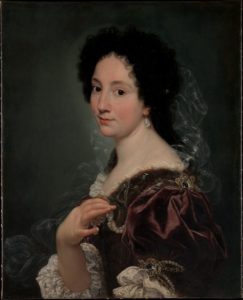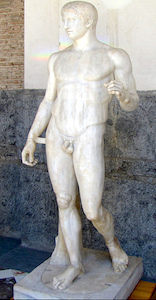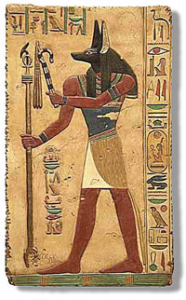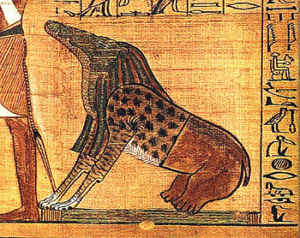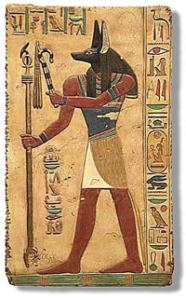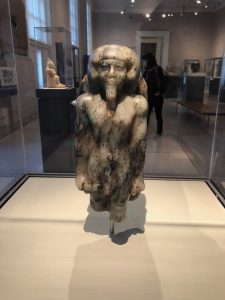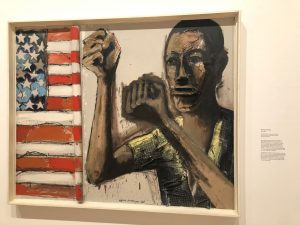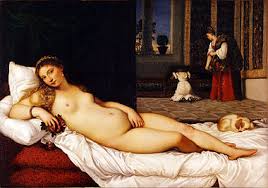Sharona Abramova
ARTD 1010 – 9:30 AM
Professor Shaw
Final Essay
Shift of Focus in Art History
Throughout history, art has been a way to understand what was going on during that era. It also has had an influence for the future generations. In civilizations such as Ancient Egypt & Mesopotamia, the focus of their works of art were the gods. The focus in art shifted from Gods in Egyptian art to humans in Greek & Roman art. This is known as Humanism. The Greeks & Romans believed that humans should be celebrated equal to or even more so than the Gods in their artwork. The art of the Greeks and Romans is known as classical art.
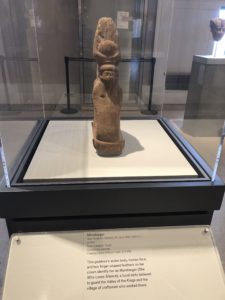
The Brooklyn Museum
Meretseger
EGYPTIAN, CLASSICAL, ANCIENT NEAR EASTERN ART Old Kingdom to 18th Dynasty
ca. 1479–1400 B.C.E.
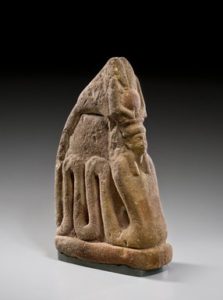
As seen here, there was an emphasis that was made on the Gods in Egyptian artwork. This goddess, whose name means “she who loves silence,” has a woman head and a cobra’s body. An animal with a human head is a common thing Egyptians did in art. Some background information is that as a local deity, Meretseger guarded the Valley of the Kings, where monarchs were placed in a tomb, and the village of craftsmen who worked there. Though a dangerous animal, her purpose was to protect the workers in the valley, and also sometimes those that did wrong things. Gods were the focus in the art pieces showing superiority over human beings. This is seen in the artwork because Meretseger is not portrayed as a human being. This shows that the gods were special because they were portrayed in a different kind of appearance compared to humans because of their animal body and were the focus in Egyptian art.
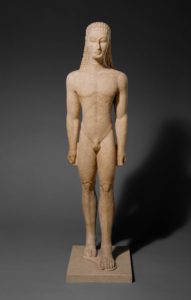
The Metropolitan Museum of Art (MET)
Marble statue of a kouros (youth)
Ancient Greece, Attic
ca. 590–580 B.C
This sculpture shows how humans became the center in art. This is one of the earliest marble statues of a human figure carved in Attica. Ideas were still taken from history. For example, the rigid stance, with the left leg forward and arms at the side was from Egyptian art. The statue marked the grave of a young Athenian aristocrat. These sculptural types displayed nudity, highlighting their unique hairstyles and abstracted musculature. He is standing while being nude to depict equality & to represent that the physical structure of humans were the same regardless of their social hierarchy.

The Metropolitan Museum of Art (MET)
Marble statue of Hermes
Roman
1st or 2nd century A.D.
The Greeks had a major influence on Roman art. This sculpture depicts a built, muscular man standing in a more confident pose in nudity. Humans, like in Greek art, were the core in Roman art. It is a Roman replica of a statue attributed to Polykleitos. Romans tend to add a touch of humor to their artwork and that’s what made them unique.
The art of the Egyptians served a different purpose than the art of the later cultures. Egyptian art was meant to benefit a divine. However, it still did influence Greek & Roman artists. The art of the Egyptians was functional and created for a practical purpose. On the other hand, the later art was intended to be for aesthetic pleasure. The statues made by the Greeks held the spirit of the god or the deceased. The Egyptians thought of art as “functional above everyone else” (Mark, 2017). The idea of “art for art’s sake” was not familiar to them. If they saw how their art is displayed at museums nowadays, it would be incomprehensible to them. Egyptian art is still admired for its beauty and one of the reasons is that they placed a value in symmetry. Egyptian art is often criticized for being not refined because there was a lack of emotion/expression on the face, always 2D, & no light/shadow in the compositions. However, Egyptians did this on purpose. They thought that a spirit of the deity would need to represented the way they are in the pieces of art in order for the soul to continue its journey in the after life and had to survive in some form on earth.
Classical art by the Greeks & Romans owes its influence to the sheer beauty of humanity. Greece was conquered by Rome in 146 BC & that’s why Greek art had a major influence on Roman art. Romans even made copies of Greek art. They believed that a copy of an artwork doesn’t have less value than the original. The copies did often have variations to them. They often added a touch humor to some somber/serious elements portrayed in Greek artwork. They had an ability to adapt & uniquely combine their inspirations from previous centuries & that’s makes Roman art Roman.
Humanism is used in Greek & Roman art and it celebrates mankind by putting an emphasis on the human body. Humanism in different art sculptures evolved as it put more detailing on the body structures and face. They emphasized the body of man by making them have certain poses and different face expressions. Egyptian art focused more on deities & gods to honor them and put them at the center. On the other hand, Greek & Roman art focused on humans and how they’re the center of events.
Works Cited
Ancient Egyptian art
Introduction to ancient Greek art
Introduction to ancient Roman art
https://www.ancient.eu/Egyptian_Art/
Gift Voucher Game 100K
https://www.brooklynmuseum.org/opencollection/objects/4178
https://www.metmuseum.org/art/collection/search/253370
https://www.metmuseum.org/art/collection/search/254925









